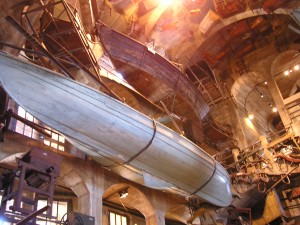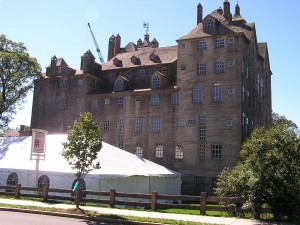The Mercer Museum — America’s Backyard Shed?
I’ve always had a soft spot for people who march to a different drummer. I’m not talking about the whackos who pick up Channel 83 while the rest of us are just getting 3, 6 and 10, but the visionaries and dreamers who are not afraid of being thought a bit odd as they pursue goals that elude others.
People like Henry Mercer, for instance.
A turn-of-the-century renaissance man born in Doylestown in 1856, Mercer was a lawyer, archeologist, anthropologist and artisan who became best known for his classic tiles. But he was also a collector and a man ahead of his time. As the Industrial Age threatened to wash away the often archaic tools that helped both native Americans and colonists settle a continent, Mercer devoted himself to preserving those tools for future generations.
And he built his own castle to house them. If the Smithsonian Institution is “America’s attic,” as it has sometimes been called, the Mercer Museum would be the backyard shed. From primitive stone tools used up to 12,000 years ago to the stagecoaches and whaling boats used by our great-grandparents, the Mercer Museum is a fascinating study into how America was built.
The castle-like museum on S. Pine Street in Doylestown is one of three unique structures erected by Mercer in the late 19th and early 20th centuries. It sits about a mile from his home, Fonthill, and the Mercer Tile Works, which can be found on Route 313 just east of Easton Road.
“Henry Mercer traveled extensively and he loved the castle structure,” says Marketing Director Gayle Shupack, noting that all three buildings share the same theme.
Completed in 1916, the six-story concrete museum is a distinct landmark in Doylestown, but the interior is equally unique. Unlike traditional museums where the exhibits are arranged neatly and in order, Mercer hung boats from the ceiling, buggies on the wall and baskets and chairs from the ceiling far above the Center Court. The museum wraps around the court as you go up each floor so that the entire facility is visible from just about any vantage point.
“He started this museum to house his collection of pre-Colonial tools and he loved concrete,” Shupack said, explaining the unique construction. “But he also wanted us to view things from a different perspective.”
Each corner of each floor is dedicated to various industries and activities from music to transportation, dentistry to grist mills.

Henry Mercer wanted visitors to see his exhibits from new perspectives and many of them hang from the walls and ceiling.
“It’s very interesting,” said Brian Topolski of Lewisbury, York County, who was visiting with his wife, Renee. Though raised in Montgomery County, the couple had never been to the Mercer and decided to do a tour while visiting relatives.
“We are both very interested in history. We went to Williamsburg (Virginia) on our honeymoon, so this is not much of a stretch for us,” Renee said.
Her husband praised the work that went into the displays. “This history and the collection they have is very extensive and they do a very good job of describing that each thing is and showing a picture of how or why it was used,” he said.
This weekend the Mercer will host its annual “Harvest Festival of the 1820s.” Visitors can watch presentations on “Bringing In the Harvest,” “Surveying and Mapping a Village” and a “Muster on the Village Green” while meeting re-enactors and participating in various activities such as doing chores in the home, visiting the local tavern and meeting the village constable.
The festival runs from 10 a.m. to 5 p.m. Saturday and from noon to 5 p.m. Sunday. See the website for admission costs.
If You Go: The Mercer Museum is open 10 a.m. to 5 p.m. Monday to Saturday and noon to 5 p.m. Sundays. Admission is $9 for adults, $8 for seniors and $4 for children 5 to 17. Children under 5 are free. Parking is available in at the lot adjacent to the Bucks County Free Library and the Michener Art Museum is located across the street from the Mercer.
What To Know: “The Mercer Mile” in Doylestown connects the museum with Fonthill and the Tile Works. Fonthill and the museum are run by the Bucks County Historical Society and the Tile Works is owned and operated by the Bucks County Parks Department.
Facts: By 1913 Mercer had collected more than 25,000 objects for eventual display in his museum. Today the museum houses more than 40,000 artifacts from around the world.









I had a wedding reception at the museum. The event was flawless, and the guests were all able to attend the exhibits.
They also do folk artist days at the museum occasionally in the summer which adds another layer of fun and learning.
Thanks for a great post!